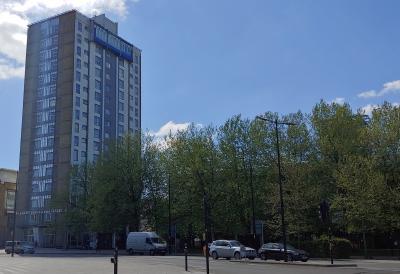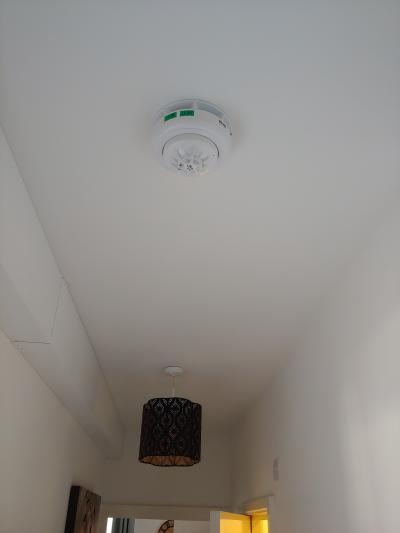St Francis Tower: ‘Staggering failures’ – Part 1: Dispensation from consultation for making a building safe
There have been several cases to come before the First Tier Tribunal (Property Chamber) where application has been made, and approved, for dispensation from consultation requirements in relation to fire safety works. The recent Tribunal decision, Re St Francis Tower, Ipswich, provides an opportunity to summarise the law in this area but also to describe some of the terrible fire safety complications that are coming to light post-Grenfell. Part 1 of this post looks at the dispensation process; Part 2 examines the particular cladding system used at St Francis Tower and why it is unsafe.
Posted:
Time to read:

St Francis Tower from a distance
Image taken by a leaseholder
St Francis Tower was originally constructed in the 1960s, and is a 17-storey block that (now) comprises 116 flats plus some commercial units on the ground floor. The original construction was a concrete frame and it underwent substantial refurbishment between 2005 and 2008, subdividing floors and increasing the number of flats. The sample lease provided to the Tribunal is a 125-year lease from June 2007 and is dated October 2011, suggesting that the flats (or at least some of them) were sold post-refurbishment. The refurbishment included overcladding with a High Pressure Laminate panel cladding system (HPL). Although this is not ACM cladding (the type used at Grenfell and the focus of most public debate), if ignited it ‘has the ability to produce two-thirds more heat than petrol’. This was not, however, the only fire hazard discovered in post-Grenfell testing. A fire strategy report concluded that the ‘risk to life is intolerable’, with serious breaches in fire compartmentation and non-compliant fire doors. There were also problems with the fire detection and AOV (automatic opening vent) systems and generally poor quality refurbishment works. In terms of making the building ‘safe’, a 4-person waking watch was put in place at a weekly cost of £10,000.
The Tribunal decision also reveals that there is some kind of further and worrying ‘story’ to this building, referring to a report from Fire Risk Consultants that says that although NHBC was intended to carry out the building control, the NHBC Guarantee was withdrawn for non-disclosed reasons, and ‘it would appear that the building has no Building Regulation sign off’. The same report also notes that the Trespa material used (Trespa Meteon 8mm) would not meet Building Regulations, even at the time of installation (although it might be more relevant to say that it would not have met the ‘Guidance’ as defined by Approved Document B at the time).
This catalogue of failures is deeply shocking, ‘staggering’ in the words of the Tribunal. The picture building up post-Grenfell is highlighting that the construction and building safety system needs a fundamental overhaul. The only ‘crumb of comfort’ offered to the Ipswich leaseholders, according to the Tribunal, is that there ‘may be a warranty backed by an insurer [Allianz] worth pursuing, if a suitable case can be made out’. Given the date of the refurbishment, it would be surprising if a claim is still within the usual 10-year warranty period.
The Dispensation Application

Inside a flat in St Francis Tower, with fire safety equipment visible
Image taken by a leaseholder
Section 20 of the Landlord and Tenant Act 1985 is intended to protect flat owners from unreasonable and unexpected costs by ensuring ‘that tenants of flats are not required (i) to pay for unnecessary services or services which are provided to a defective standard, and (ii) to pay more than they should for services which are necessary and are provided to an acceptable standard.’ (Lord Neuberger in Daejan Investments Limited v Benson, 2013). The twin aims – of protecting owners from paying for inappropriate or poor quality work, or of paying too much – are supported by a requirement that the building owner consult with the flat owners before committing to major items of expense. The consultation requirements, contained in Part 2 of Schedule 4 of the Service Charges (Consultation Requirements) (England) Regulations 2003, apply where the works are ‘qualifying works’ and have the effect that only £250 can be recovered from a tenant in respect of such works unless the consultation requirements have either been complied with or dispensed with.
At St Francis Tower, leaseholders had recently received invoices of around £19,000 per flat, and there was expected to be a future top-up of a ‘few thousand pounds’. The Tribunal case concerned a request to dispense with the consultation stage. This is NOT the same question as to whether the costs are reasonable, the works are done to a good quality, or the costs are recoverable under the wording of the lease. These questions commonly form later Tribunal applications. Nor do dispensation applications deal what is the real complaint in many of these cases: that the leaseholders should not have to pay because they bought in good faith believing that the building was built to appropriate standards. In Re Babbage Point, the leaseholders objected to paying and argued that ‘the cost should be met by the original developers and/or the NHBC scheme’. However, the question of who is ultimately responsible for the cost of rectifying defects (or, perhaps ‘should be’) may, as the Tribunal noted in Re Nova House, involve questions of contract or tort. These are not matters for the Tribunal but for a civil court, and, as pointed out in an earlier blogpost, these private law civil claims will not be easy.
Turning now to the law relating to getting dispensation from the consultation requirements, under section 20ZA Landlord and Tenant Act 1985, the Tribunal can grant dispensation if it is reasonable to do so. The Supreme Court in Daejan Investments Limited v Benson provides guidance on how this is to be approached. The focus should be on whether the leaseholders were prejudiced by any failure to consult; neither the financial consequence to the landlord if dispensation is not given, nor the ‘nature’ of the landlord, are relevant factors in exercising the discretion. Prejudice is the key factor in most cases, and this involves looking at any evidence that the leaseholders have provided to show that, perhaps, the work could have been carried out differently, or at less cost, had there been consultation.
In Re St Francis Tower, Ipswich, the application was to cover dispensation for the works of compartmentation, removing cladding, installing a fire alarm, suppression systems, and the AOVs. No mention is made of the waking watch costs. Unsurprisingly, dispensation was granted: the works needed to be done quickly and although the landlord had not formally consulted there had been engagement with leaseholders, both ‘in writing and at meetings that included lengthy question and answer sessions’. This has been the outcome with most applications for dispensation from consultation for fire safety works (see, for example, Re The Works Apartments; Re Orchards Estate; Re Century House). The Citiscape application for dispensation was unusual; the applicant (Firstport Property Services Limited) intended to consult but to reduce the period for leaseholder response from the usual 30 days to only 7 days; a number of leaseholders had opposed the application with concerns that this abridgement would effectively exclude them from the process and give insufficient time to evaluate the plans and suggest an alternative contractor; and also they required more information about the fire safety audits, etc. In granting dispensation the Tribunal attached conditions for Firstport to comply with, including the provision of specified information.
In the majority of urgent fire safety applications, the dispensation stage has become a bit of a formality and one which adds to the overall costs. There are seldom any leaseholder objections and leaseholders find it difficult to provide evidence of prejudice as this may well effectively require them to obtain alternative quotations. Invariably these are urgent works, and, as the Tribunal notes in Re St Francis Tower, Ipswich, the formal consultation process is lengthy and can take at least 3 months.
Selling Flats

One of the impacts of fire safety issues emerging post-Grenfell is that, unsurprisingly, properties can be hard to sell. In the recent Radio 5 Live Investigates programme, it was noted that fire safety issues have blighted properties (this was in the context of blocks that do not meet the most recent higher standards). At St Francis Tower, one flat sold in August 2012 for £53,500; more than six years later the same flat has sold for significantly less, even though the block is undergoing remediation (the Rightmove listing shows it as sold at auction for £41,000 in March – although the same page also says £30,000 STC).
In the next part of this post, Jonathan Evans considers how St Francis Tower is constructed.
__________
How to cite this blog post (Harvard style)
Bright, S. (2019). St Francis Tower: ‘Staggering failures’ – Part 1: Dispensation from consultation for making a building safe. Available at: https://www.law.ox.ac.uk/housing-after-grenfell/blog/2019/05/st-francis-tower-staggering-failures-part-1-dispensation. (Accessed [date]).
Share:
